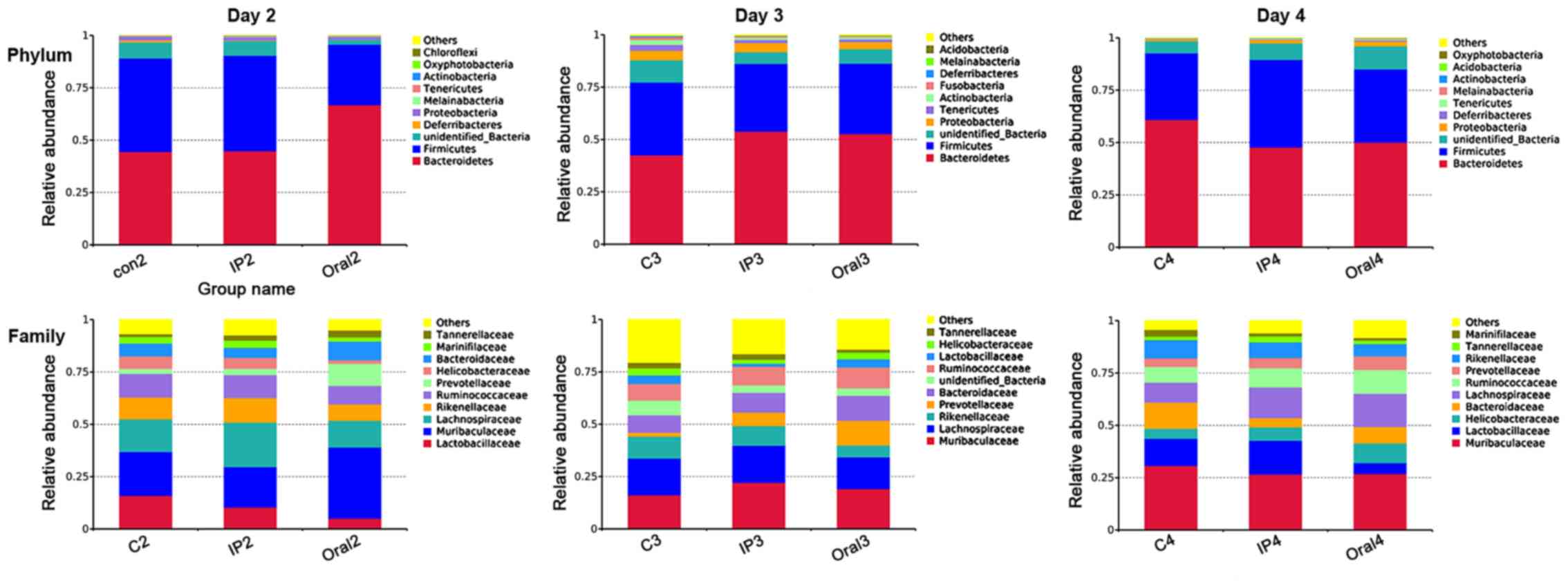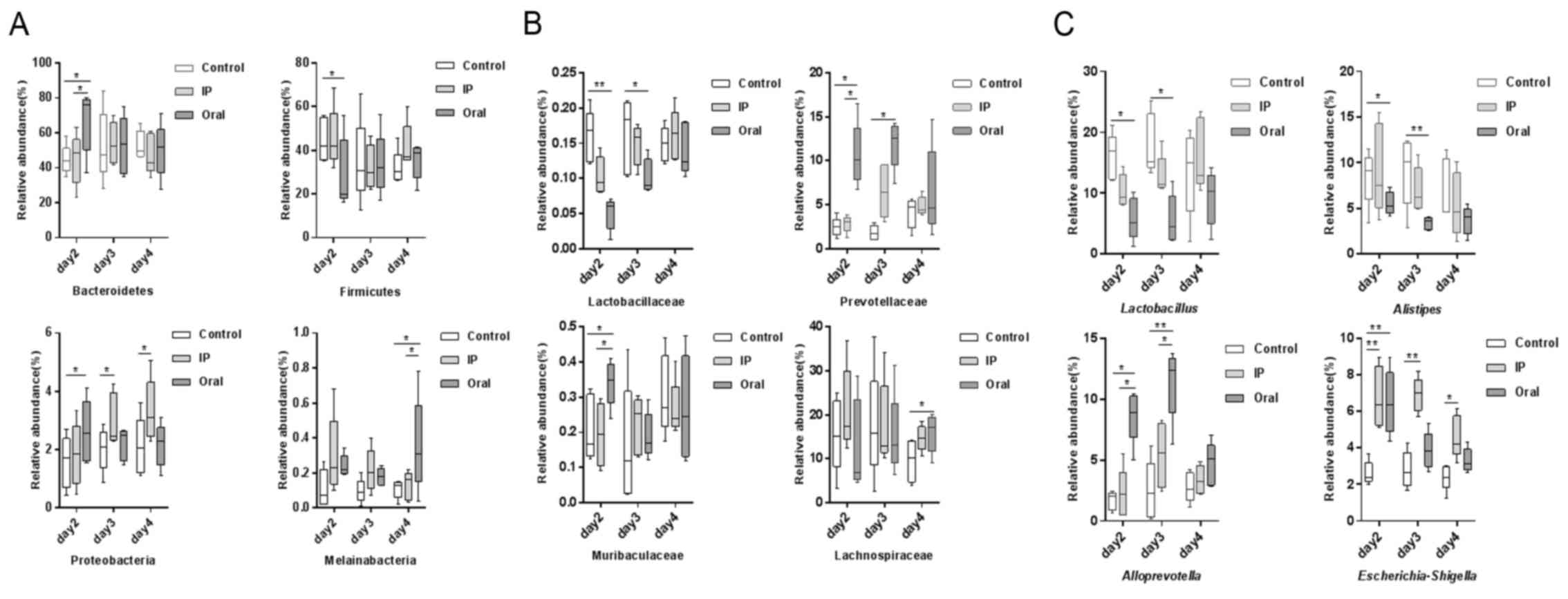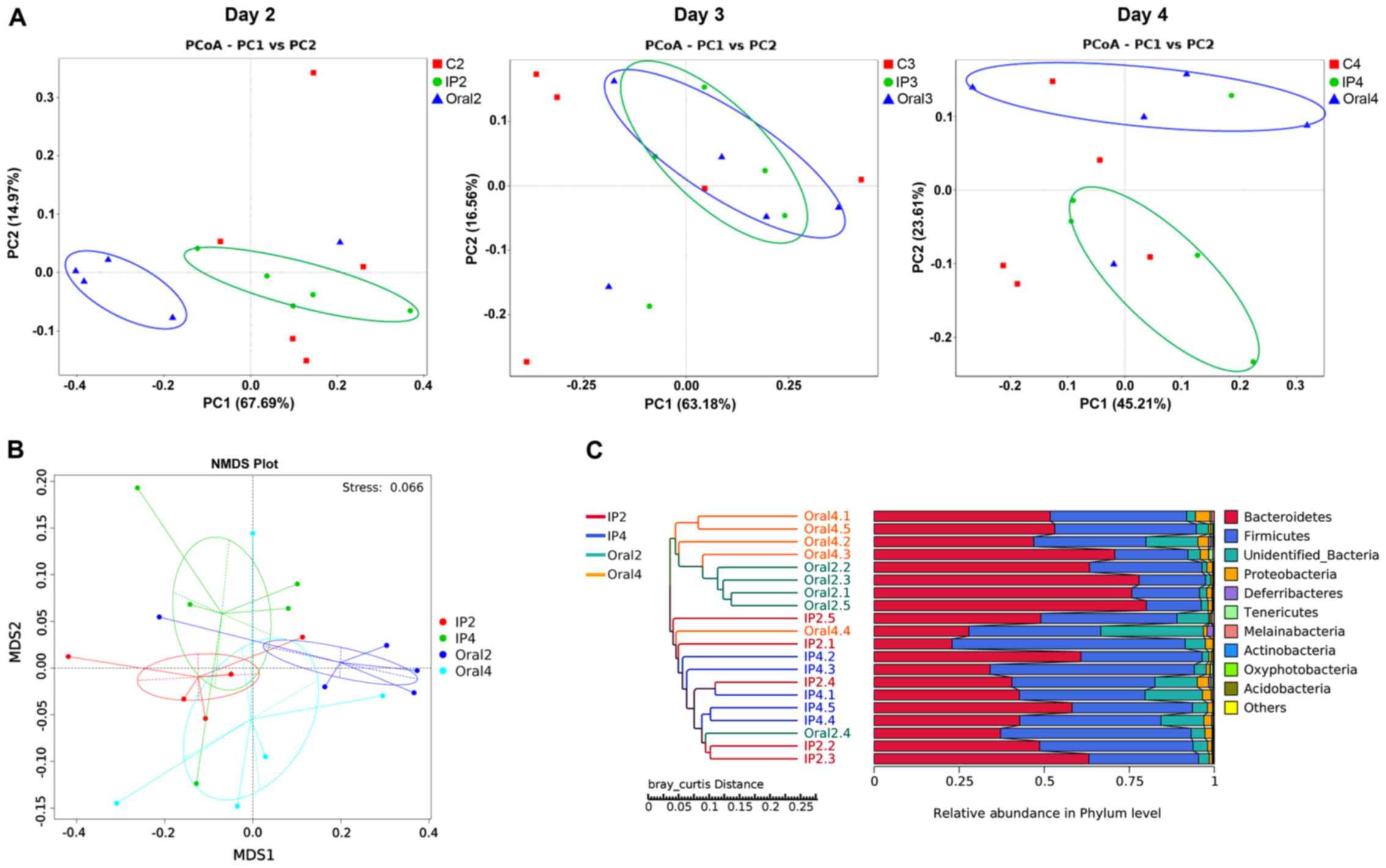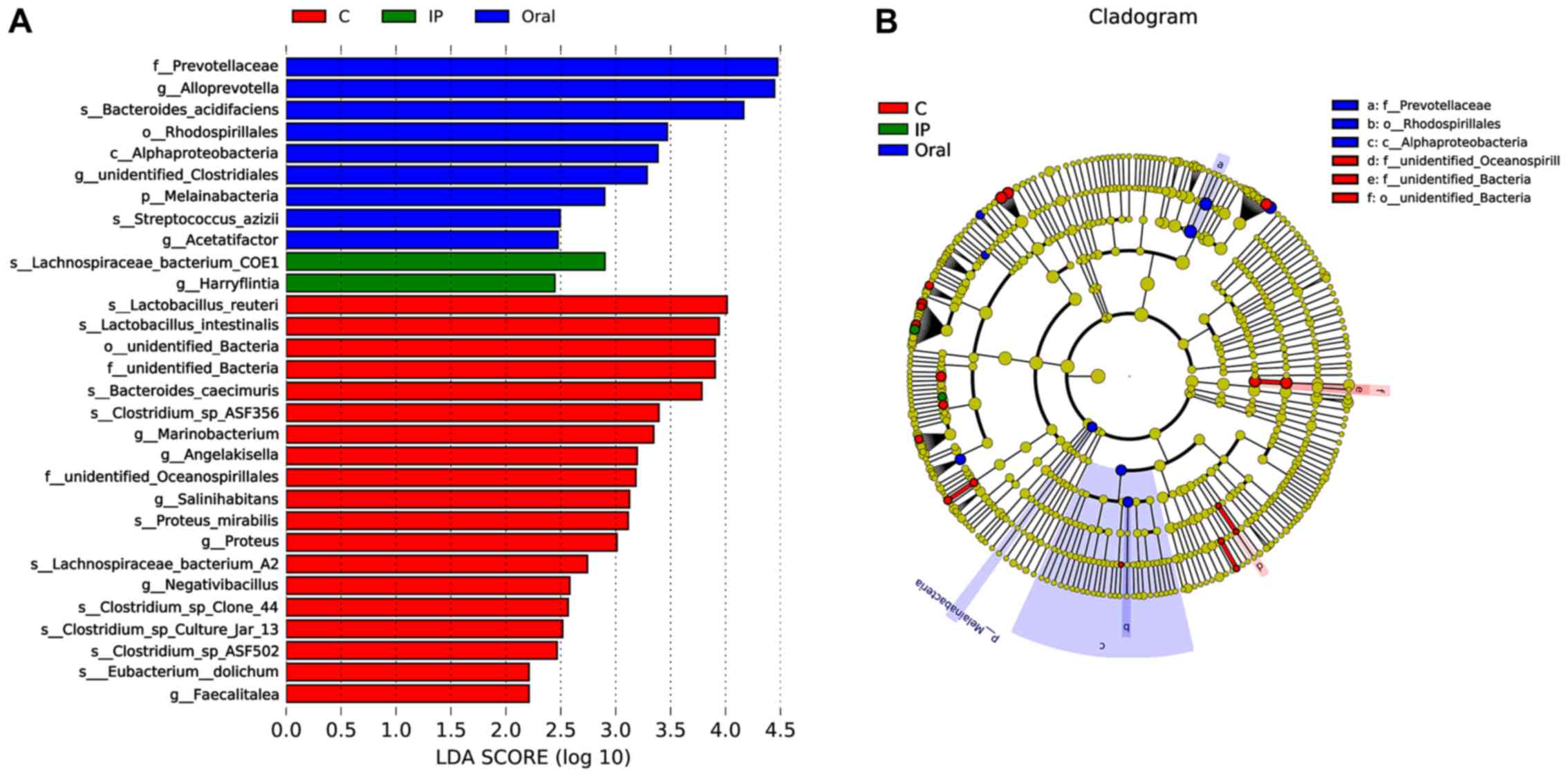|
1
|
Kotloff KL, Riddle MS, Platts-Mills JA,
Pavlinac P and Zaidi AKM: Shigellosis. Lancet. 391:801–812. 2018.
View Article : Google Scholar : PubMed/NCBI
|
|
2
|
Chang Z, Zhang J, Ran L, Sun J, Liu F, Luo
L, Zeng L, Wang L, Li Z, Yu H and Liao Q: The changing epidemiology
of bacillary dysentery and characteristics of antimicrobial
resistance of Shigella isolated in China from 2004–2014. BMC Infect
Dis. 16:6852016. View Article : Google Scholar : PubMed/NCBI
|
|
3
|
Taneja N and Mewara A: Shigellosis:
Epidemiology in India. Indian J Med Res. 143:565–576. 2016.
View Article : Google Scholar : PubMed/NCBI
|
|
4
|
Mattock E and Blocker AJ: How do the
virulence factors of shigella work together to cause disease? Front
Cell Infect Microbiol. 7:642017. View Article : Google Scholar : PubMed/NCBI
|
|
5
|
Takeuchi A: Early colonic lesions in
experimental Shigella infection in rhesus monkeys: Revisited. Vet
Pathol Suppl. 7:1–8. 1982. View Article : Google Scholar : PubMed/NCBI
|
|
6
|
Kotloff KL, Winickoff JP, Ivanoff B,
Clemens JD, Swerdlow DL, Sansonetti PJ, Adak GK and Levine MM:
Global burden of Shigella infections: Implications for vaccine
development and implementation of control strategies. Bull World
Health Organ. 77:651–666. 1999.PubMed/NCBI
|
|
7
|
Al-Soub H, Al-Maslamani M, Al-Khuwaiter J,
El-Deeb Y and El-Shafie SS: Shigella flexneri perinephric abscess
and bacteremia. Ann Saudi Med. 25:419–421. 2005. View Article : Google Scholar : PubMed/NCBI
|
|
8
|
Drow DL, Mercer L and Peacock JB: Splenic
abscess caused by Shigella flexneri and Bacteroides fragilis. J
Clin Microbiol. 19:79–80. 1984. View Article : Google Scholar : PubMed/NCBI
|
|
9
|
Amstey MS and Gandell DL:
Salpingitis-perihepatitis in a patient with cervical Shigella
sonnei. Obstet Gynecol. 55 (3 Suppl):70S–71S. 1980. View Article : Google Scholar : PubMed/NCBI
|
|
10
|
Jasper JM and Ward MA: Shigella
vulvovaginitis in a prepubertal child. Pediatr Emerg Care.
22:585–586. 2006. View Article : Google Scholar : PubMed/NCBI
|
|
11
|
Upadhyay AK and Neely JA: Toxic megacolon
and perforation caused by Shigella. Br J Surg. 76:12171989.
View Article : Google Scholar : PubMed/NCBI
|
|
12
|
Miron D, Sochotnick I, Yardeni D, Kawar B
and Siplovich L: Surgical complications of shigellosis in children.
Pediatr Infect Dis J. 19:898–900. 2000. View Article : Google Scholar : PubMed/NCBI
|
|
13
|
Yang JY, Lee SN, Chang SY, Ko HJ, Ryu S
and Kweon MN: A mouse model of shigellosis by intraperitoneal
infection. J Infect Dis. 209:203–215. 2014. View Article : Google Scholar : PubMed/NCBI
|
|
14
|
Sommer F and Backhed F: The gut
microbiota-masters of host development and physiology. Nat Rev
Microbiol. 11:227–238. 2013. View Article : Google Scholar : PubMed/NCBI
|
|
15
|
Vogt SL and Finlay BB: Gut
microbiota-mediated protection against diarrheal infections. J
Travel Med. 24 (Suppl 1):S39–S43. 2017. View Article : Google Scholar : PubMed/NCBI
|
|
16
|
Bhattacharjee S, Kalbfuss N and Prazeres
da Costa C: Parasites, microbiota and metabolic disease. Parasite
Immunol. 392017.doi: 10.1111/pim.12390.
|
|
17
|
Munoz-Vargas L, Opiyo SO, Digianantonio R,
Williams ML, Wijeratne A and Habing G: Fecal microbiome of
periparturient dairy cattle and associations with the onset of
Salmonella shedding. PLoS One. 13:e01961712018. View Article : Google Scholar : PubMed/NCBI
|
|
18
|
Pearson JA, Tai N, Ekanayake-Alper DK,
Peng J, Hu Y, Hager K, Compton S, Wong FS, Smith PC and Wen L:
Norovirus changes susceptibility to type 1 diabetes by altering
intestinal microbiota and immune cell functions. Front Immunol.
10:26542019. View Article : Google Scholar : PubMed/NCBI
|
|
19
|
Sun X, Gao Y, Wang X, Hu G, Wang Y, Feng
B, Hu Y, Mu X, Zhang Y and Dong H: Escherichia coli O101-induced
diarrhea develops gut microbial dysbiosis in rats. Exp Ther Med.
17:824–834. 2019.PubMed/NCBI
|
|
20
|
Olfert ED and Godson DL: Humane endpoints
for infectious disease animal models. ILAR J. 41:99–104. 2000.
View Article : Google Scholar : PubMed/NCBI
|
|
21
|
Edgar RC: UPARSE: Highly accurate OTU
sequences from microbial amplicon reads. Nat Methods. 10:996–998.
2013. View Article : Google Scholar : PubMed/NCBI
|
|
22
|
Hugerth LW and Andersson AF: Analysing
microbial community composition through amplicon sequencing: From
sampling to hypothesis testing. Front Microbiol. 8:15612017.
View Article : Google Scholar : PubMed/NCBI
|
|
23
|
Lozupone C, Lladser ME, Knights D,
Stombaugh J and Knight R: UniFrac: An effective distance metric for
microbial community comparison. ISME J. 5:169–172. 2011. View Article : Google Scholar : PubMed/NCBI
|
|
24
|
Ramette A and Tiedje JM: Multiscale
responses of microbial life to spatial distance and environmental
heterogeneity in a patchy ecosystem. Proc Natl Acad Sci USA.
104:2761–2766. 2007. View Article : Google Scholar : PubMed/NCBI
|
|
25
|
Segata N, Izard J, Waldron L, Gevers D,
Miropolsky L, Garrett WS and Huttenhower C: Metagenomic biomarker
discovery and explanation. Genome Biol. 12:R602011. View Article : Google Scholar : PubMed/NCBI
|
|
26
|
Ashkenazi S: Shigella infections in
children: New insights. Semin Pediatr Infect Dis. 15:246–252. 2004.
View Article : Google Scholar : PubMed/NCBI
|
|
27
|
Sharma D, Yagnik B, Baksi R, Desai N, Padh
H and Desai P: Shigellosis murine model established by
intraperitoneal and intranasal route of administration: A
comparative comprehension overview. Microbes Infect. 19:47–54.
2017. View Article : Google Scholar : PubMed/NCBI
|
|
28
|
Fernandez MI, Thuizat A, Pedron T, Neutra
M, Phalipon A and Sansonetti PJ: A newborn mouse model for the
study of intestinal pathogenesis of shigellosis. Cell Microbiol.
5:481–491. 2003. View Article : Google Scholar : PubMed/NCBI
|
|
29
|
Q S Medeiros PH, Ledwaba SE, Bolick DT,
Giallourou N, Yum LK, Costa DVS, Oriá RB, Barry EM, Swann JR, Lima
AÂM, et al: A murine model of diarrhea, growth impairment and
metabolic disturbances with Shigella flexneri infection and the
role of zinc deficiency. Gut Microbes. 10:615–630. 2019. View Article : Google Scholar : PubMed/NCBI
|
|
30
|
Kim BR, Shin J, Guevarra R, Lee JH, Kim
DW, Seol KH, Lee JH, Kim HB and Isaacson R: Deciphering diversity
indices for a better understanding of microbial communities. J
Microbiol Biotechnol. 27:2089–2093. 2017. View Article : Google Scholar : PubMed/NCBI
|
|
31
|
Shim DH, Ryu S and Kweon MN: Defensins
play a crucial role in protecting mice against oral Shigella
flexneri infection. Biochem Biophys Res Commun. 401:554–560. 2010.
View Article : Google Scholar : PubMed/NCBI
|
|
32
|
Davoodabadi A, Soltan Dallal MM, Lashani E
and Tajabadi Ebrahimi M: Antimicrobial Activity of Lactobacillus
spp. Isolated from fecal flora of healthy breast-fed infants
against diarrheagenic Escherichia coli. Jundishapur J Microbiol.
8:e278522015. View Article : Google Scholar : PubMed/NCBI
|
|
33
|
Zhang YC, Zhang LW, Ma W, Yi HX, Yang X,
Du M, Shan YJ, Han X and Zhang LL: Screening of probiotic
lactobacilli for inhibition of Shigella sonnei and the
macromolecules involved in inhibition. Anaerobe. 18:498–503. 2012.
View Article : Google Scholar : PubMed/NCBI
|
|
34
|
Alamdary SZ, Bakhshi B and Soudi S: The
anti-apoptotic and anti-inflammatory effect of Lactobacillus
acidophilus on Shigella sonnei and Vibrio cholerae interaction with
intestinal epithelial cells: A comparison between invasive and
non-invasive bacteria. PLoS One. 13:e01969412018. View Article : Google Scholar : PubMed/NCBI
|
|
35
|
Mirnejad R, Vahdati AR, Rashidiani J,
Erfani M and Piranfar V: The antimicrobial effect of lactobacillus
casei culture supernatant against multiple drug resistant clinical
isolates of Shigella sonnei and Shigella flexneri in vitro. Iran
Red Crescent Med J. 15:122–126. 2013. View Article : Google Scholar : PubMed/NCBI
|
|
36
|
Zhang Y, Shi X, Hao S, Lu Q, Zhang L, Han
X and Lu W: Inhibition of Shigella sonnei-induced epithelial
barrier disruption by surface-layer associated proteins of
lactobacilli from Chinese fermented food. J Dairy Sci.
101:1834–1842. 2018. View Article : Google Scholar : PubMed/NCBI
|
|
37
|
Archambaud C, Nahori MA, Soubigou G,
Bécavin C, Laval L, Lechat P, Smokvina T, Langella P, Lecuit M and
Cossart P: Impact of lactobacilli on orally acquired listeriosis.
Proc Natl Acad Sci USA. 109:16684–16689. 2012. View Article : Google Scholar : PubMed/NCBI
|
|
38
|
Larsen JM: The immune response to
Prevotella bacteria in chronic inflammatory disease. Immunology.
151:363–374. 2017. View Article : Google Scholar : PubMed/NCBI
|
|
39
|
Su T, Liu R, Lee A, Long Y, Du L, Lai S,
Chen X, Wang L, Si J, Owyang C and Chen S: Altered intestinal
microbiota with increased abundance of Prevotella is associated
with high risk of diarrhea-predominant irritable bowel syndrome.
Gastroenterol Res Pract. 2018:69617832018. View Article : Google Scholar : PubMed/NCBI
|
|
40
|
Maeda Y and Takeda K: Role of gut
microbiota in rheumatoid arthritis. J Clin Med. 6(pii): E602017.
View Article : Google Scholar : PubMed/NCBI
|
|
41
|
Szafranski SP, Deng ZL, Tomasch J, Jarek
M, Bhuju S, Meisinger C, Kühnisch J, Sztajer H and Wagner-Döbler I:
Functional biomarkers for chronic periodontitis and insights into
the roles of Prevotella nigrescens and Fusobacterium nucleatum; a
metatranscriptome analysis. NPJ Biofilms Microbiomes. 1:150172015.
View Article : Google Scholar : PubMed/NCBI
|
|
42
|
Kageyama A, Benno Y and Nakase T:
Phylogenetic and phenotypic evidence for the transfer of
Eubacterium aerofaciens to the genus Collinsella as Collinsella
aerofaciens gen. nov., comb. nov. Int J Syst Bacteriol. 49:557–565.
1999. View Article : Google Scholar : PubMed/NCBI
|
|
43
|
Mu Q, Tavella VJ and Luo XM: Role of
Lactobacillus reuteri in human health and diseases. Front
Microbiol. 9:7572018. View Article : Google Scholar : PubMed/NCBI
|
|
44
|
Chen S, Chen L, Chen L, Ren X, Ge H, Li B,
Ma G, Ke X, Zhu J, Li L, et al: Potential probiotic
characterization of Lactobacillus reuteri from traditional Chinese
highland barley wine and application for room-temperature-storage
drinkable yogurt. J Dairy Sci. 101:5780–5788. 2018. View Article : Google Scholar : PubMed/NCBI
|
|
45
|
Sokol H, Pigneur B, Watterlot L, Lakhdari
O, Bermúdez-Humarán LG, Gratadoux JJ, Blugeon S, Bridonneau C,
Furet JP, Corthier G, et al: Faecalibacterium prausnitzii is an
anti-inflammatory commensal bacterium identified by gut microbiota
analysis of Crohn disease patients. Proc Natl Acad Sci USA.
105:16731–16736. 2008. View Article : Google Scholar : PubMed/NCBI
|
|
46
|
Benus RF, Harmsen HJ, Welling GW,
Spanjersberg R, Zijlstra JG, Degener JE and van der Werf TS: Impact
of digestive and oropharyngeal decontamination on the intestinal
microbiota in ICU patients. Intensive Care Med. 36:1394–1402. 2010.
View Article : Google Scholar : PubMed/NCBI
|
|
47
|
Kameyama K and Itoh K: Intestinal
colonization by a Lachnospiraceae bacterium contributes to the
development of diabetes in obese mice. Microbes Environ.
29:427–430. 2014. View Article : Google Scholar : PubMed/NCBI
|
|
48
|
Zeng H, Ishaq SL, Zhao FQ and Wright AG:
Colonic inflammation accompanies an increase of β-catenin signaling
and Lachnospiraceae/Streptococcaceae bacteria in the hind gut of
high-fat diet-fed mice. J Nutr Biochem. 35:30–36. 2016. View Article : Google Scholar : PubMed/NCBI
|



















